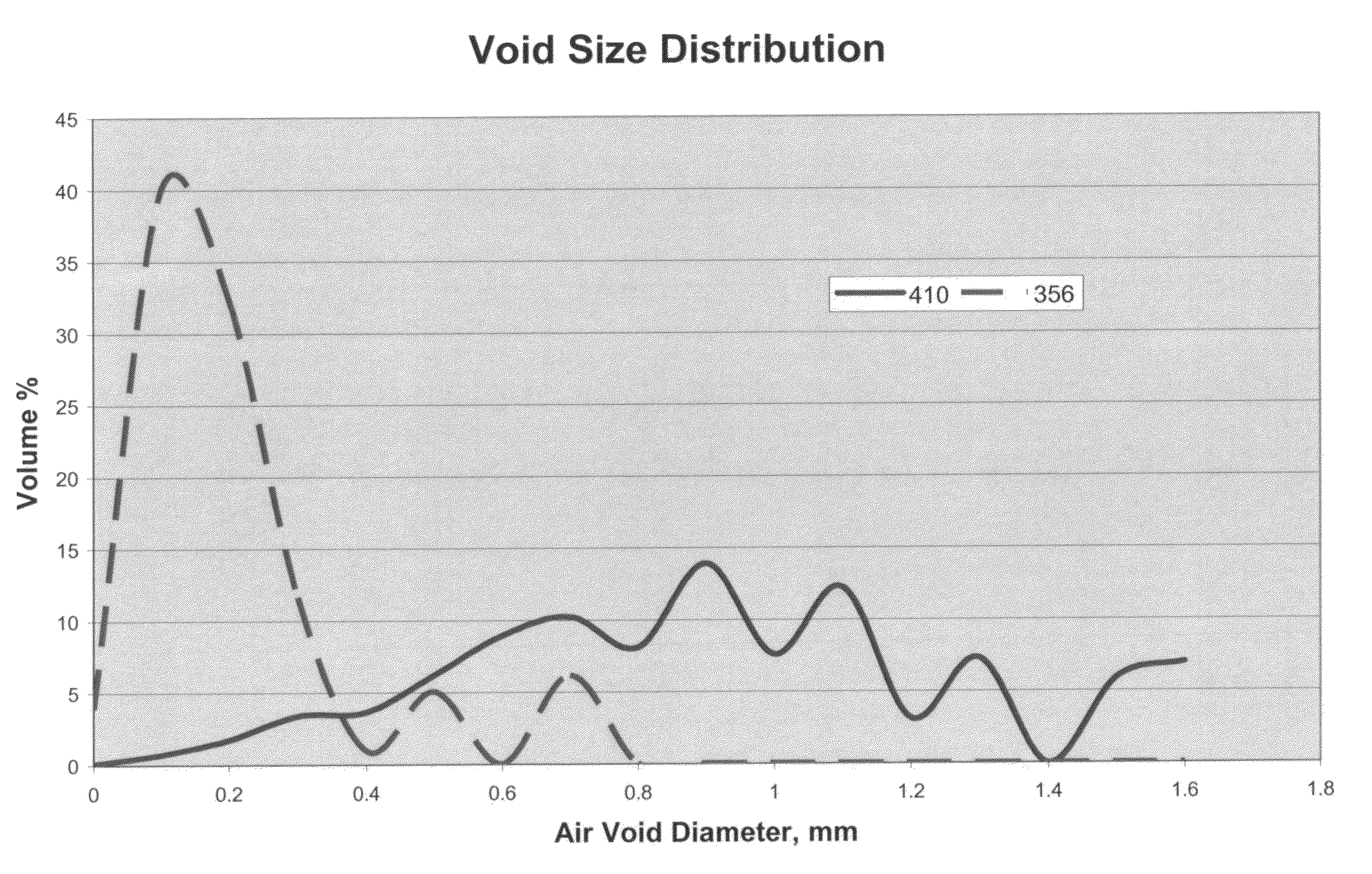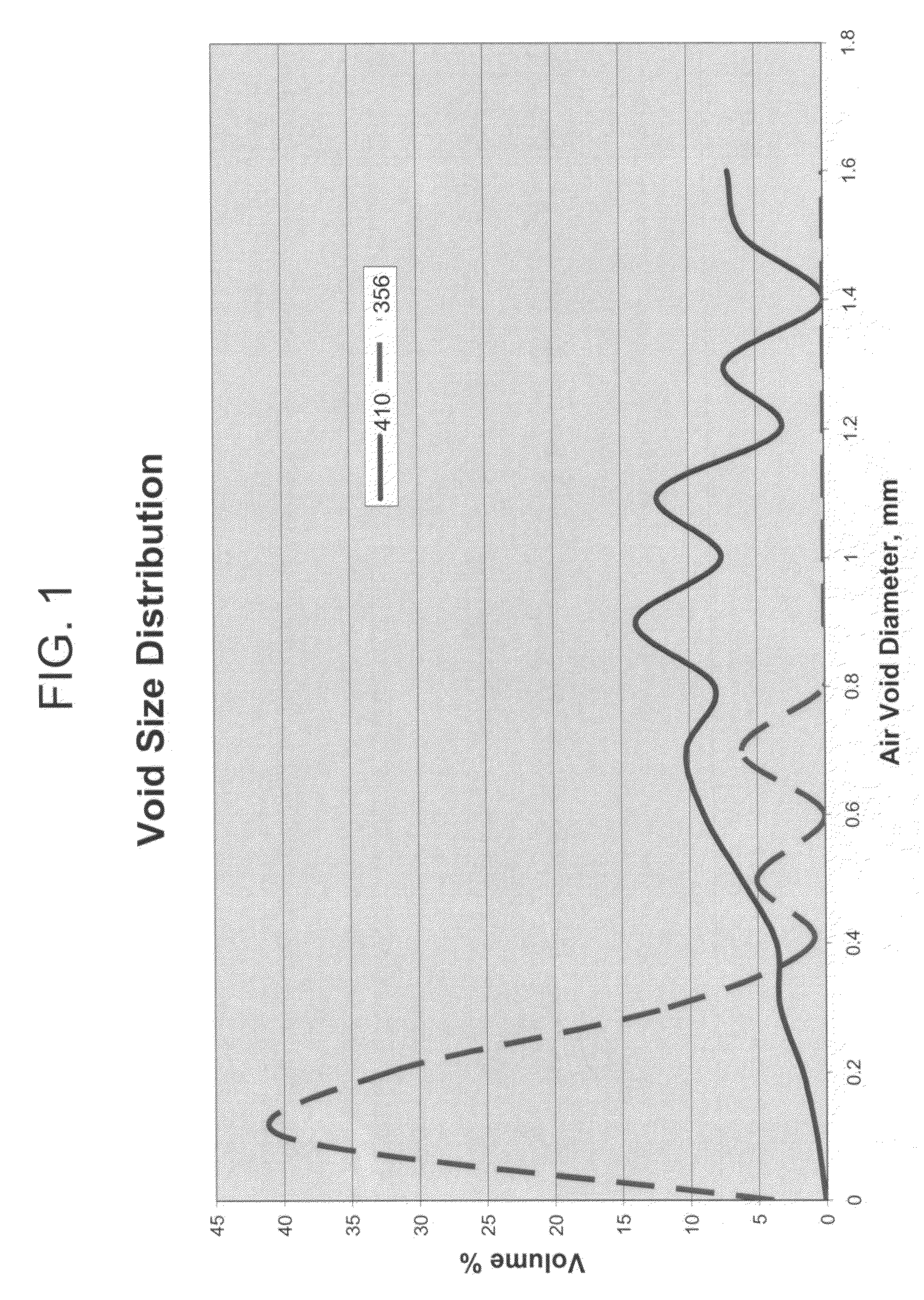Foamed slurry and building panel made therefrom
a technology of foaming slurry and foaming slurry, which is applied in the field of foaming slurry, can solve the problems of fatigue of installers who work with the foaming panels, low cost effectiveness of foaming building panels, and relatively heavy weight of foaming panels, so as to improve the control of the distribution of foaming bubbles and improve the control of large bubbles
- Summary
- Abstract
- Description
- Claims
- Application Information
AI Technical Summary
Benefits of technology
Problems solved by technology
Method used
Image
Examples
example 1
[0092]A plant trial was conducted to compare naphthalene sulfonate condensate dispersants (“NS”) with polycarboxylate dispersants. During the trial, a constant line speed of 215 ft / min of gypsum building panel was produced. The components used in each sample and the process conditions are shown in Table 1 below. Unless otherwise noted, the amount of each of the remaining components is listed in pounds per 1000 square feet of building panel product. “WSR” is the water to stucco ratio, where both foam water, additive water and gauging water are included. Glass fibers were added to all samples at the rate of 0.32% based on the stucco weight. Dextrose was added at 0.17% based on the stucco weight. These two components were added to each of the samples.
[0093]Two polycarboxylate dispersants were used. MELFLUX PCE 356 L / 35% ND (“356”) was a dispersant in water without defoamer and without the optional surfactant. MELFLUX PCE 410 L / 35% FF was an aqueous mixture of a polycarboxylate dispersa...
example 2
[0100]About 600 grams of calcined gypsum from a western gypsum source was used to make a slurry having a water stucco ratio (WSR) of 0.64. Melflux PCE 410 L / 35% FF was added in amounts to provide constant patty size from a slump test.
[0101]Foam was generated in a separate foam generator and added to the mixer during the last part of the mixing time. The foam was prepared with a foam generator from a mixture of soap and foam water that included about 0.75% soap. The soap was a 90:10 blend of HYONIC PFM-33 (GEO Specialty Chemicals, Ambler, Pa.) and Steol CS-330. (Stepan Co., Northfield, Ill.). The following procedure describes the remaining process conditions.
[0102]The mixing sequence and procedure follows:
[0103]1. Water, dispersant, and additives were placed in the Hobart mixer bowl and then mixed by hand.
[0104]2. Stucco pre-blended with accelerator and specific additives were added to the bowl and soaked for a short time before the mechanical mixing begins.
[0105]3. During mixing, fo...
example 3
[0114]About 600 grams of calcined gypsum from a western gypsum source was used to make a slurry having a water stucco ratio (WSR) of 0.730. This WSR was selected in order to achieve a slump patty size of 18±0.5 cm without any dispersant or retarder.
[0115]Foam was generated in a separate foam generator and added to the mixer during the last part of the mixing time. The foam was prepared with a foam generator from a mixture of soap and foam water that included about 0.75% soap. The soap was added with various blends of HYONIC PFM-33 (Geo Specialty Chemicals, Lafayette, Ind.) and Steol CS-330 (Stepan Co., Northfield, Ill.) to produce a similar core void distribution in all cases. The following procedure describes the remaining process conditions.
[0116]The mixing sequence and procedure follows:
[0117]1. Water, any dispersant, and additives were placed in the Hobart mixer bowl and then mixed by hand.
[0118]2. Stucco pre-blended with accelerator and specific additives were added to the bowl...
PUM
| Property | Measurement | Unit |
|---|---|---|
| diameter | aaaaa | aaaaa |
| molecular weights | aaaaa | aaaaa |
| molecular weights | aaaaa | aaaaa |
Abstract
Description
Claims
Application Information
 Login to View More
Login to View More - R&D
- Intellectual Property
- Life Sciences
- Materials
- Tech Scout
- Unparalleled Data Quality
- Higher Quality Content
- 60% Fewer Hallucinations
Browse by: Latest US Patents, China's latest patents, Technical Efficacy Thesaurus, Application Domain, Technology Topic, Popular Technical Reports.
© 2025 PatSnap. All rights reserved.Legal|Privacy policy|Modern Slavery Act Transparency Statement|Sitemap|About US| Contact US: help@patsnap.com



